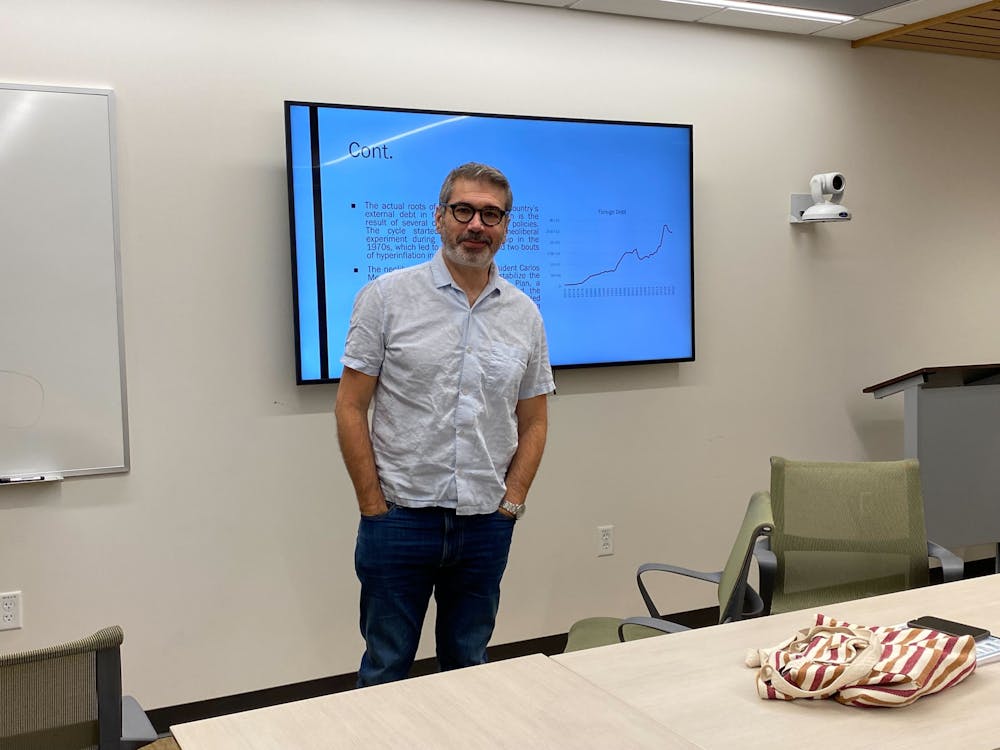On Oct. 31, Matías Vernengo, a professor of economics at Bucknell University, gave a talk titled “La Argentina de Javier Milei: 10 Months Later,” which centered around Argentina’s economic issues and current President Javier Milei’s approach to resolving them. Hosted by the Latin American, Caribbean and Latinx Studies department, as well as the International Studies department, the event shed light on the political dynamics that impede Argentina’s economic development.
To discuss the roots of Argentina’s current economic stagnation, Vernengo opened with historical background from the nineteenth century. He explained that the country’s GDP per capita rose steadily from the 1870s to the 1980s (with the accompanying rise of neoliberalism), which was partially due to authoritarian modernization.
However, he described that Argentina’s debt rose suddenly in 1976 when a military junta overthrew the Peronist government and implemented policies that killed thousands of suspected political dissidents and led to a highly unstable market. In turn, the International Monetary Fund granted billions of dollars in loans to restabilize Argentina’s economy. However, Vernengo highlighted that as the external debt accrued, Argentina’s economic growth mired — an issue that persists today.
Bringing the discussion to modern politics, Vernengo described the correlation between past leaders and Argentina’s external debt. He touched upon Cristina Fernández de Kirchner, president of Argentina from 2007 to 2015, who imposed controls on exports and prices to combat inflation, and Mauricio Macri, president from 2015 to 2019, who attempted to address inflation by devaluing the peso and removing export controls.
“In 2018, [the Macri administration] eliminated the capital controls that [Cristina Fernández de Kirchner] had; [the Macri administration] had to reimpose it [and] got the biggest loan in the IMF’s history,” he said.
He then spoke about the policies under the Milei administration that have led to Argentina’s inflation and dollarization, which is the process of adopting US dollars in place of a country’s currency because the local currency is unstable. Specifically, Milei’s administration has maintained an interest rate lower than the adjusted interest rate on dollars. He added that while Argentina’s reserves have increased in the short term, its external debt has also increased, causing the ratio of reserves to debt to fall below one, which is not sustainable.
Vernengo explained that Milei’s devaluation policies contribute to a cycle that increases Argentina’s dollarization.
“If the interest rate in pesos is lower than the expected depreciation of the dollar, holding dollars is better.... You make more money by holding $1 than by holding onto an interest-bearing peso. On top of this, you can always put your dollar in some US Treasury bonds, so there is an asset that will pay you some interest in dollars, even if it’s low,” he said.
Analyzing the effects of dollarization, Vernengo reflected on how it has exacerbated inflation, which increased poverty rates.
“Once you depreciate, prices go up and wages have to go up with prices. Once wages go up, you have to increase prices. And we’re in conflict inflation,“ he said. “[Milei] entered and depreciated the currency by 100%, so the [exchange rate] changed from 400 pesos per dollar to 800 pesos per dollar.”
Placing economic developments in a broader context, Vernengo went on to introduce the Argentine pendulum, an idea that attributes Argentina’s economic developments to shifts between Peronism (an ideology based on the legacy of Juan Perón) and neoliberalism (an ideology encouraging free market competition). He described that under Peronist governments, the economy tended toward industrialization with high wages, while neoliberal governments were characterized by industrialization with low wages.
However, Vernengo explained that recent years have altered the pendulum — it now oscillates between deindustrialization and industrialization rather than Peronism and neoliberalism. He noted that, while industrializing, Argentina’s growth is limited by its resources (e.g., capital, technology). During these periods, it needs to import resources from other countries; however, this ultimately increases dollarization and thus limits the rate at which the economy can grow.
Instead of dollarizing, Vernengo advocates for a higher interest rate differential, citing similar policies during the tenures of Luiz Inácio Lula da Silva in Brazil that successfully accumulated great amounts of reserves.
“Brazil, with Lula, was having humongous account and trade surpluses. But during a long period, Brazil did not have them. How did they do that? A very high rate of interest. So, the interest rate differential is the central sort of story. If you want to think of why Argentina is dollarized, why Argentina has high inflation, it’s ultimately associated with this,” he said.
He concluded that a dollarized economy would be hard to reverse, comparing Argentina’s economy to those of Ecuador and South Korea.
After the presentation, moderators opened the floor for questions. An audience member asked about Milei’s enduring popularity despite his economic policies, to which Vernengo responded that right-wing governments gain popularity when unemployment is high.
When asked about the accuracy of the pendulum, Vernengo also qualified that the model is flawed because it implies that the economy changes in a cyclical manner, whereas it evolves differently according to current social conditions.
In an interview with The News-Letter, attendee sophomore Claire Nalda reflected on how her views had changed after the talk.
“I think that one thing that shifted for me was the idea that the right-wing is solely based on ideology,” she said. “I think that hearing about how the economic policies impact [the rise of the right] helped me understand it in a broader context.”





